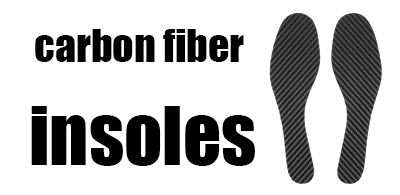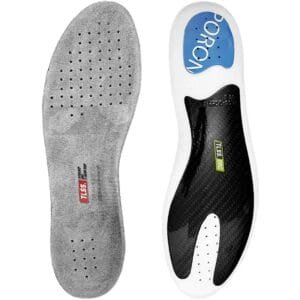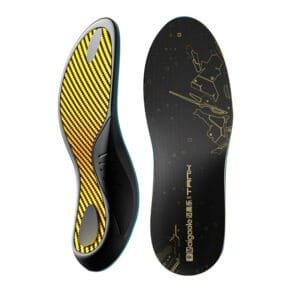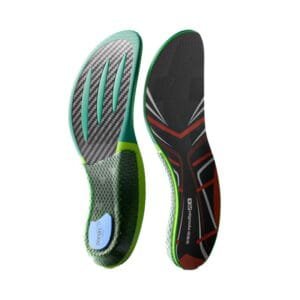Pour les coureurs, chaque pas compte. Des chaussures adaptées peuvent faire la différence entre un record personnel et une fatigue douloureuse. Alors que la plupart des gens se concentrent sur les chaussures, semelles en fibre de carbone sont en train de devenir une arme secrète pour les coureurs d'élite et les coureurs amateurs. Mais qu'est-ce qui les rend si efficaces ?
Cet article se penche sur les biomécanique des semelles en fibre de carboneEn examinant la façon dont ils améliorer l'efficacité de la course, réduire la perte d'énergie et prévenir les blessures courantes comme la fasciite plantaire. Nous les comparerons aux semelles traditionnelles en mousse EVA, passerons en revue les études scientifiques et répondrons à des questions clés telles que "Les semelles en fibre de carbone sont-elles bonnes pour les marathoniens ?
À la fin, vous comprendrez pourquoi semelles de course en fibre de carbone et s'ils vous conviennent.
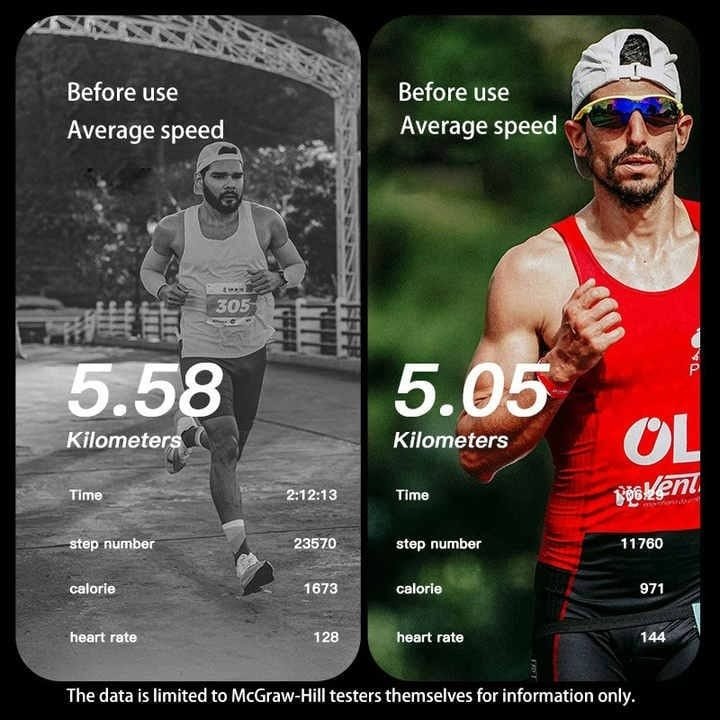
1. La science des semelles en fibre de carbone : Comment elles fonctionnent
La fibre de carbone est un matériau léger et ultra résistant utilisé dans l'aérospatiale et les sports de haut niveau. Appliquée aux semelles intérieures, elle offre des avantages uniques :
A. Rendement énergétique et efficacité de fonctionnement
Contrairement à la mousse EVA souple, qui se comprime et absorbe l'énergie, les semelles en fibre de carbone agissent comme un ressortL'énergie est emmagasinée et restituée à chaque foulée.
Une étude de 2022 dans la Journal of Sports Engineering and Technology (Journal de l'ingénierie et de la technologie du sport) a constaté que les plaques en fibre de carbone dans les chaussures de course améliorent l'économie de course de 4%-Des principes similaires s'appliquent aux semelles en carbone.
Rapport des coureurs moins de fatigue musculaire sur de longues distances grâce à la réduction des pertes d'énergie.
B. Impact réduit sur les articulations
Rigidité de la fibre de carbone répartit uniformément la pressionLes chaussures de sport peuvent être utilisées en toute sécurité, ce qui réduit la pression sur les genoux, les chevilles et les hanches.
Recherche en Médecine et sciences du sport et de l'exercice (2021) ont montré que des semelles plus rigides réduction des forces d'impact jusqu'à 15%et diminue ainsi le risque de blessure.
C. Stabilité et alignement des pieds
La surpronation (enroulement excessif du pied vers l'intérieur) est un problème courant chez les coureurs.
Semelles en fibre de carbone limiter les mouvements excessifsL'utilisation de l'orthèse plantaire permet d'améliorer l'alignement et de réduire la tension sur le fascia plantaire.
2. Semelles en fibre de carbone ou semelles en EVA : Quelle est la meilleure solution pour les coureurs ?
| Fonctionnalité | Semelles en fibre de carbone | Semelles EVA traditionnelles |
|---|---|---|
| Retour d'énergie | Élevé (effet de ressort) | Faible (absorbe l'énergie) |
| Durabilité | Extrêmement durable | Se comprime avec le temps |
| Poids | Ultra-léger | Plus lourd grâce à la mousse |
| Soutien | Ferme, stabilise le pied | Souple, moins porteur |
| Meilleur pour | Vitesse, efficacité, prévention des blessures | Amortissement (courses courtes) |
Principaux enseignements : Si vous donnez la priorité vitesse, efficacité et prévention des blessuresLa fibre de carbone est supérieure. L'EVA est meilleur pour les coureurs occasionnels qui préfèrent l'amorti.
-
$159.00Le prix initial était : $159.00.$93.99Le prix actuel est : $93.99. -
$134.00Le prix initial était : $134.00.$89.99Le prix actuel est : $89.99.
3. Comment les semelles en fibre de carbone aident à prévenir les blessures en course à pied
A. Soulagement de la fasciite plantaire
La fasciite plantaire (douleur au talon) est causée par une tension répétitive sur le fascia plantaire.
Semelles en fibre de carbone réduire les micro-déchirures en offrant un soutien ferme de la voûte plantaire et en limitant les étirements excessifs.
A 2023 Journal of Foot & Ankle Research (en anglais) L'étude a montré que les semelles rigides ont réduit la tension du fascia plantaire de 18% par rapport aux semelles souples.
B. Fractures du tibia et fractures de stress
Les chocs excessifs provoquent des lésions tibiales et des fractures de stress.
La fibre de carbone dispersion des chocs minimise le stress répétitif sur les os.
C. Soutien du tendon d'Achille
La structure rigide réduit la flexion excessive de la chevilleLa réduction de l'élongation du tendon d'Achille.
4. Les semelles en fibre de carbone sont-elles bonnes pour les marathoniens ?
Oui, voici pourquoi :
✅ Amélioration de l'économie de course - Moins d'énergie gaspillée signifie une meilleure endurance.
✅ Fatigue retardée - Les muscles restent frais sur de plus longues distances.
✅ Prévention des blessures - Indispensable pour les entraînements de longue durée.
5. FAQ : Semelles en fibre de carbone pour coureurs
Q : Les semelles en fibre de carbone sont-elles confortables ?
R : Ils sont fermes, pas pelucheux, mais optimisés pour la performance, pas pour la douceur.
Q : Puis-je utiliser des semelles en fibre de carbone dans n'importe quel type d'appareil ? chaussure de course?
R : Oui, ils sont conçus pour s'adapter à la plupart des chaussures de course.
Q : Quelle est la durée de vie des semelles en fibre de carbone ?
R : Beaucoup plus longtemps que la mousse - typiquement 1 à 2 ans en cas d'utilisation intensive.
Q : Ces produits valent-ils leur prix ?
R : Si vous courez régulièrement, le amélioration des performances et prévention des blessures justifier le coût.
Conclusion : Devriez-vous passer aux semelles en fibre de carbone ?
Si vous voulez vraiment courir, que ce soit pour la vitesse, l'endurance ou la prévention des blessures, il est important d'avoir une bonne connaissance de la course à pied.Les semelles en fibre de carbone offrent des avantages scientifiquement prouvés. Ils améliorent le retour d'énergie, réduisent le stress articulaire et vous permettent de courir plus fort et plus longtemps.
Prêt à améliorer votre course ? Achetez nos semelles en fibre de carbone haute performance ici.
